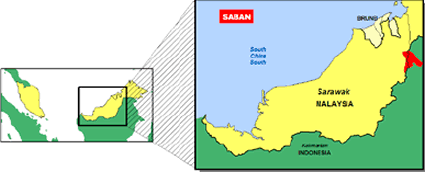The Sa'ban are a small people group living in the Punang Kelapang region in the remote Kelabit Highlands of northeast Sarawak. Long Banga is the main Sa'ban village in the highlands. Many Sa'ban have also moved to urban areas such as Miri for work purposes.
The Sa'ban originally lived in the upper reaches of the Bahau River in east Kalimantan. Migration to Sarawak began around 1900 and continued until the late 1960s.
Despite sharing many cultural similarities with the neighboring Kelabit, the Sa'ban are a distinct people who even today seldom intermarry with outsiders. Historically, their warriors were renowned for their bravery and steadfastness in battle.
They live in Indonesia and Malaysia.
A typical Sa'ban village consists of houses built in an alignment similar to that of a longhouse. Nowadays, individual houses are also built in the villages. Farming is a major economic activity. They practice shifting paddy cultivation. Coffee and sugarcane are planted as cash crops. The Sa'ban are an industrious people. They have a strong desire to improve their standard of living.
Many Sa'ban have taken up jobs in urban areas. They also work in the logging and plantation industries. The level of education among the Sa'ban is high. Schoolchildren normally have to finish their higher secondary school education in faraway towns. A few individuals are university and college graduates. The Sa'ban live in extended families. The adoption of children among close relatives is common. Sa'ban society consists of aristocrats and commoners. Formerly there was also a slave class. Village heads are usually elected from the aristocratic class.
A Sa'ban couple changes their names upon the births of their first child and first grandchild. Parents also address their children using special terms. Certain traditional practices, such as elongating earlobes and tattooing, have almost died out among both men and women. The practice of keeping antique jars and beads as heirlooms continues even today.
The Sa'ban previously practiced animism. Deep in spirit-worship, they kept the skulls of their enemies in their longhouses.
In the early 1950s, the first Protestant Christian missionaries went to the Sa'ban people. The Sa'ban responded positively and the people today are predominantly Christians. Christmas and Easter celebrations are looked forward to as a time of festivities and family reunions.
The migration of the younger Sa'ban generation to urban areas will doubtlessly bring drastic changes to their social structure. They need to actively try to preserve their culture so it will not be lost.
The geographical isolation of the Sa'ban poses a problem for more community development to be carried out. They need improved transportation links with the outside world.
Pray that believers would share the hope that is within them.
Pray for the Holy Spirit to move powerfully in Sa'ban families and churches, drawing them into a close relationship with the Lord.
Pray that soon Sa'bans will be discipling those who need Christ.
Scripture Prayers for the Sa'ban in Malaysia.
Southeast Asia Link – SEALINK, Copyrighted © Used with permission.
| Profile Source: Joshua Project |












